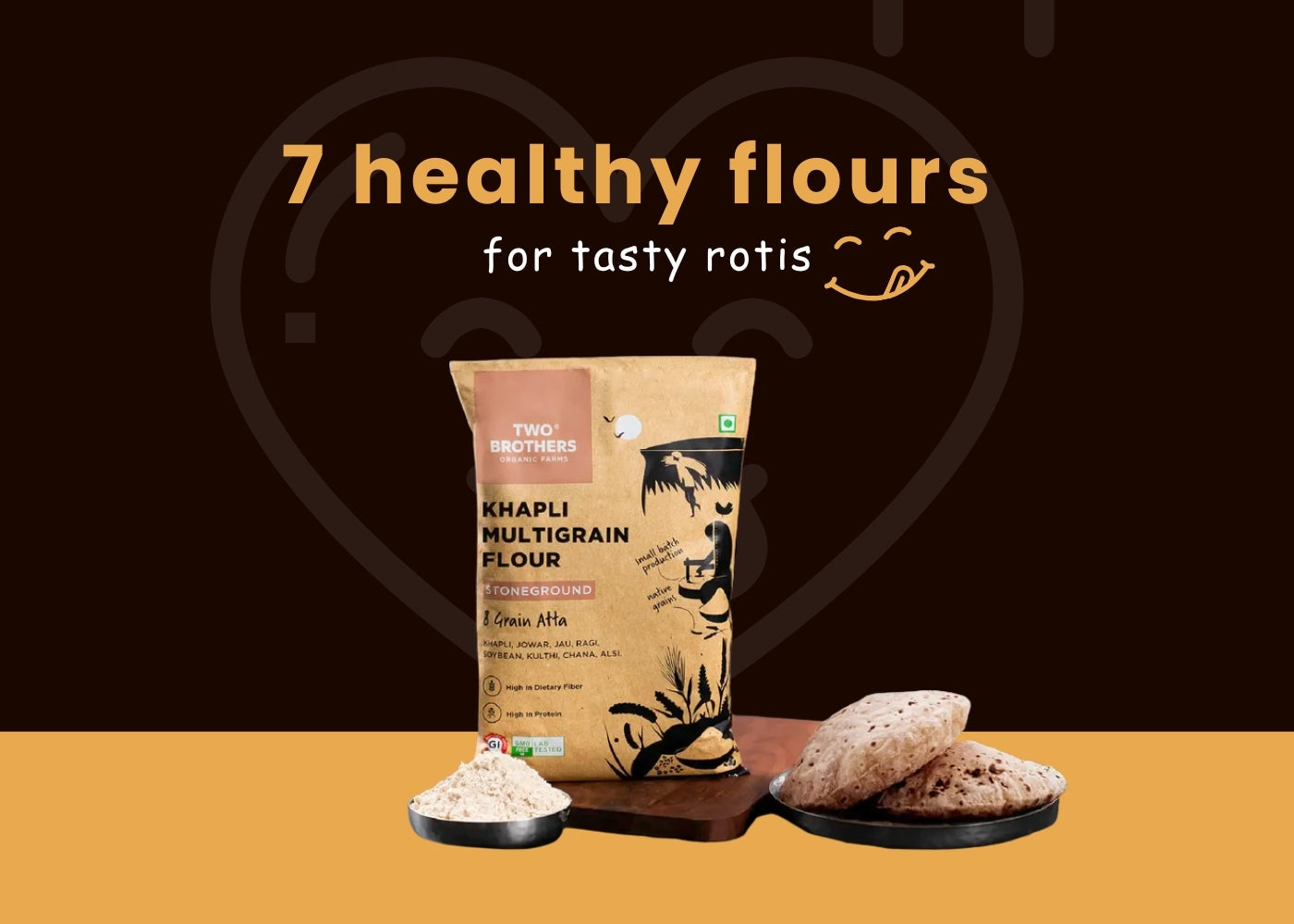Does Your Daily Roti Leave You Feeling Heavy?
You wake up, have your morning chai with a fresh roti, and an hour later, there it is. That uncomfortable fullness. The bloating that makes you want to unbutton your jeans. The sluggish feeling that drags you down before noon even hits.
Sound familiar?
Here's the thing: it might not be what you ate, but what your atta is made of that's causing the trouble. Modern wheat flour has changed dramatically over the past few decades. What once nourished generations has been hybridized, processed, and stripped of its natural goodness, leaving behind a product that many stomachs simply can't handle anymore.
But there's good news. Ancient grains like Khapli wheat are making a comeback, and they're offering a gentler, healthier path forward for anyone struggling with digestive discomfort.
Let's talk about the five warning signs your regular atta might be the problem, and why switching to Khapli atta could be the relief you've been searching for.
What Modern Wheat Flour Is Really Doing to Your Stomach
Before we dive into the symptoms, let's understand what's happened to the wheat we eat today.
Modern wheat flour is often highly processed. The bran and germ, where most of the fiber, vitamins, and minerals live, are removed during refining. What's left is a starchy, high-gluten powder that digests quickly, spikes your blood sugar, and offers little nutritional value.
On top of that, modern wheat has been bred to contain more gluten than its ancient ancestors. This stronger, more complex gluten structure is what makes bread fluffy and rotis soft, but it's also what makes them harder to digest, especially for people with sensitivities.
In contrast, Khapli wheat, also known as emmer wheat, is an ancient, unhybridized grain. It's minimally processed, naturally lower in gluten, and packed with fiber. It's what wheat used to be before we started tinkering with it.
5 Silent Signs Your Atta Is Quietly Sabotaging Your Digestion
1. That Post-Meal Bloating That Won't Quit
This is the big one. If you feel like your stomach is a balloon ready to pop after eating rotis or chapatis, your body might be struggling to break down the gluten in modern wheat flour.
Bloating happens when gas gets trapped in your digestive system. High-gluten flours can ferment in the gut, especially if your digestion is slow or sensitive. The result? That uncomfortable, tight feeling that lingers for hours.
Khapli atta has a weaker gluten structure that's easier to digest. Many people notice a significant reduction in bloating within just a few days of making the switch.
Related Read: Can Khapli Atta Help with Bloating?
2. The Uncomfortable Gas and Cramping Nobody Talks About
Gas, cramping, and that "gurgly" stomach are signs your gut is working overtime. Modern wheat can trigger these symptoms, especially in people with gluten sensitivity or IBS (Irritable Bowel Syndrome).
The complex gluten in regular atta can irritate the lining of your intestines, leading to inflammation and discomfort. Over time, this can weaken your gut's ability to absorb nutrients properly.
Khapli wheat, on the other hand, is gentler. Its simpler gluten structure means less irritation and smoother digestion. Plus, its high fiber content helps move things along naturally, reducing the chance of gas buildup.
Learn More: Does Your Atta Cause Bloating? Try This Low-Gluten Alternative
3. When Your Bathroom Schedule Becomes Your Worst Enemy
When your digestion swings between extremes, constipation one day, loose stools the next, it's a sign something's off. Refined wheat flour lacks the fiber your gut needs to function smoothly. Without fiber, your digestive system slows down, leading to constipation.
At the same time, if your body is sensitive to the gluten in regular atta, it might speed things up too much, causing diarrhea or urgency.
Khapli atta is naturally high in dietary fiber, which promotes regular, healthy bowel movements. It supports your gut microbiome, feeds good bacteria, and keeps your digestion balanced.
4. The 3 PM Energy Crash That Steals Your Afternoon
Ever notice how you feel sleepy or mentally foggy after a big meal? That's not just food coma; it could be your body reacting to what you ate.
Modern wheat has a high glycemic index (GI), meaning it causes your blood sugar to spike quickly. What goes up must come down, and when it does, you're left feeling drained, irritable, and unable to focus.
For people with gluten sensitivity, the inflammation caused by regular atta can also contribute to brain fog and chronic fatigue.
Khapli wheat has a lower glycemic index, which means it releases energy slowly and steadily. No spikes, no crashes, just sustained energy that keeps you going throughout the day.
5. That Burning Heartburn You Keep Ignoring
If you're reaching for antacids after eating rotis, your wheat flour might be to blame. Refined and processed atta can be harder for your stomach to break down, leading to acid buildup and that burning sensation in your chest.
Ancient grains like Khapli are considered more alkaline and easier on the stomach. They digest smoothly without triggering excess acid production, making them a better choice for anyone prone to heartburn or GERD.
The Ancient Grain Revolution: Why Khapli Atta Changes Everything
Let's break it down side by side. Here's how Khapli atta compares to regular wheat flour:
|
Feature |
Regular Atta (Modern Wheat) |
Khapli Atta (Emmer Wheat) |
|
Gluten Content |
High, strong, complex gluten structure |
Lower; weaker, more digestible gluten |
|
Fiber Content |
Often low (especially if refined) |
High in dietary fiber |
|
Glycemic Index |
High (causes blood sugar spikes) |
Low (steady energy release) |
|
Processing |
Heavily processed, stripped of nutrients |
Minimally processed, stone-ground |
|
Digestibility |
Harder to digest; may cause bloating and discomfort |
Easier to digest; gentle on the gut |
|
Nutritional Value |
Lower (bran and germ removed) |
Rich in magnesium, iron, B vitamins, antioxidants |
Deep Dive: Khapli Atta for Gut Health: High-Fiber Ancient Wheat Benefits
Your 4-Step Roadmap to a Happier, Healthier Gut
Switching to Khapli atta doesn't mean overhauling your entire diet. It's as simple as swapping out your regular flour and continuing to make the rotis, parathas, and breads you already love.
Here's how to get started:
Step 1: Choose Quality
Not all Khapli atta is created equal. Look for organic, stone-ground options that retain the full nutritional profile of the grain. Two Brothers Organic Farms offers authentic, farm-fresh Khapli Multigrain Atta that's perfect for everyday cooking.
Step 2: Start Slow
If your body is used to regular wheat, give it a few days to adjust. You might notice less bloating and more energy right away, or it might take a week or two. Be patient with yourself.
Step 3: Stay Consistent
Make Khapli your go-to flour for all your meals. The more consistent you are, the better your digestion will become.
Step 4: Pair It Right
Eat your Khapli rotis with fiber-rich vegetables, probiotic-rich yogurt, and healthy fats like ghee. This combination supports gut health and makes digestion even smoother.
Why Two Brothers Isn't Just Another Brand—It's a Promise
At Two Brothers Organic Farms, we believe food should nourish, not harm. That's why we grow our Khapli wheat using regenerative farming practices, no synthetic pesticides, no GMOs, just pure, traditional agriculture.
Our Khapli aata is stone-ground in small batches to preserve every bit of its natural goodness. It's high in fiber, rich in nutrients, and gentle on your gut, exactly what your body needs.
When you choose Two Brothers, you're not just buying flour. You're choosing a healthier, more sustainable way of eating.
Your Gut Knows What It Needs—Are You Ready to Listen?
Your body knows what it needs, and if your regular wheat flour is causing bloating, fatigue, or digestive discomfort, it's time to listen.
Switching to Khapli atta isn't just about avoiding symptoms. It's about choosing a flour that truly nourishes you, one that's rooted in tradition, rich in nutrition, and kind to your gut.
Make the switch today. Your stomach and your whole body will thank you.
Shop Khapli Multigrain Atta from Two Brothers Organic Farms
FAQs
1. Is Khapli atta completely gluten-free?
No, Khapli wheat contains gluten, but it has a weaker, more digestible gluten structure compared to modern wheat. It's suitable for people with mild gluten sensitivity but not for those with celiac disease.
2. Can I use Khapli atta for all my regular recipes?
Absolutely! You can use Khapli atta to make rotis, parathas, bread, pancakes, and more. It works just like regular atta, but with better nutrition and easier digestion.
3. Will I lose weight by switching to Khapli atta?
While Khapli wheat has a lower glycemic index and more fiber, both of which support healthy weight management, it's not a magic solution. Combined with a balanced diet and an active lifestyle, it can definitely help.
4. How soon will I notice a difference after switching?
Many people report feeling less bloated and more energized within just a few days. Others may take a week or two to notice significant changes, depending on their body and overall diet.
5. Where can I buy authentic Khapli atta?
You can buy high-quality, organic Khapli atta directly from Two Brothers Organic Farms, trusted by health-conscious families across the USA.
6. Is Khapli atta safe for kids and elderly people?
Yes! Khapli atta is gentle, nutritious, and easy to digest, making it ideal for all age groups, from growing children to seniors with sensitive stomachs.









